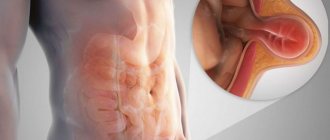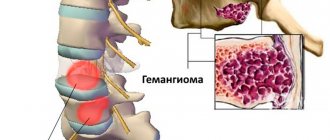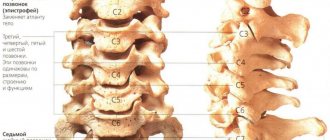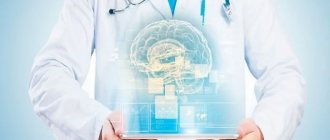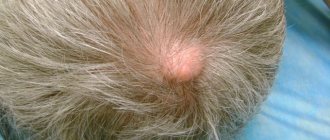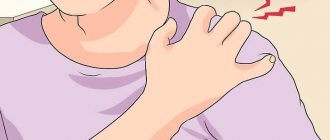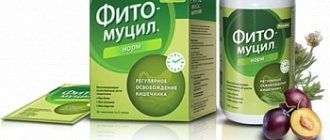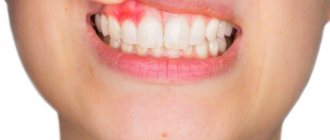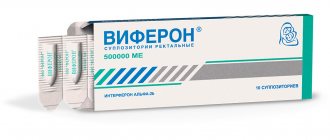Schmorl's hernia is a disease in which the intervertebral disc protrudes not in the horizontal plane, but in the vertical, and presses through the vertebral body. Its bone structure is destroyed and pressed vertically - up or down, the cartilage tissue of the disc fills the resulting cavity.
Diagnosis by MRI.
The pathology is often hereditary and develops mainly in adolescent children and the elderly due to degenerative processes in the structures of the spinal column.
General information about the disease
The intervertebral disc consists of an elastic core surrounded by a durable fibrous membrane. Under the influence of certain pathological factors, the shell becomes thinner and breaks, and the core begins to form a small cavity in the vertebral bone, simultaneously filling it. This disease is asymptomatic for a long time and is often detected accidentally during examination for one reason or another. Only with significant volumes of the formation does it begin to bulge beyond the boundaries of the vertebra, causing symptoms of compression of the nerve roots, similar to a classic intervertebral hernia.
Formations often occur in adolescents against the background of rapid skeletal growth. In this case, the most typical location is the thoracic region. Adults are more likely to experience Schmorl's hernias, which have formed in the lumbar spine due to increased load on the musculoskeletal system.
Make an appointment
Pathogenesis
Depending on the etiology, disorders of the vertebral structure can develop in different ways:
- the pathogenesis of congenital Schmorl's hernia is based on weakness and inferiority of cartilage tissue, impaired blood supply to the growing disc;
- in old and senile age, osteoarthritis or osteoporosis causes degenerative changes in cartilage tissues, disrupts their structure, which leads to loss of strength and elasticity, and further formation of a knot;
- injuries can cause disc defects, breakthrough of tissues of the nucleus pulposus, formed under the influence of large and sudden mechanical force, for example, due to an impact, fracture, dislocation, subluxation.
What is Schmorl's hernia?
Schmorl's nodes in the spine are simply a herniated intervertebral disc, formed by pushing through the intervertebral endplates of the body of an adjacent vertebra (upper or lower) by cartilage tissue. They can be congenital or acquired - as a result of degenerative processes or injuries of the thoracic or lumbar spine.
Schmorl's cartilaginous nodes extend beyond the fibrous ring and can have a median, paramedian, foraminal and extraforaminal location.
On x-rays, Schmorl's nodes appear in the form of narrowing of the intervertebral spaces, uneven contours of the end plates and slight beak-like growths along the edges, while signs of calcification of the nucleus pulposus or annulus fibrosus are revealed, as well as the “vacuum phenomenon” - slit-like clearing in the anterior parts of the intervertebral discs.
Causes
The reasons contributing to the appearance of Schmorl's hernia include:
- hereditary predisposition: often the pathology is congenital or develops in the first years of life;
- uneven growth, in which bones lag behind cartilage in development;
- intense physical activity and accompanying microtraumas of the spinal column (weight lifting, some sports, excess body weight, pregnancy);
- single intense physical activity: falling, lifting a heavy object in the wrong position;
- vertebral deformation due to osteoporosis or spondyloarthrosis (in old age);
- impaired blood supply to the spinal column;
- lack of microelements: calcium, vitamin D;
- metabolic disorders;
- postural disorders, scoliosis, thoracic kyphosis;
- osteochondrosis;
- sedentary lifestyle.
Why is this happening?
The cause of the disease is thinning of the vertebral body spongiosum. There are many reasons for this.
The first and main thing is insufficient nutrition. Any tissues, including bone structures, require nutrients and oxygen for normal functioning. With an insufficiently active lifestyle, this replenishment stops and the vertebra begins to “decrepit”. Voids form in it, Schmorl's hernia appears, and sometimes compression fractures appear.
The second reason is osteoporosis. Yes, this terrible disease that occurs with age also leads to such consequences. The vertebral membrane is depleted and the voids begin to fill with cartilaginous tissue of the intervertebral disc.
The third is also related to age, but it applies to teenagers. During this transitional period, the body is formed so quickly that sometimes the vertebrae cannot keep up with its growth. And this all leads to the same failures in the spongy body.
Fourth - deformation of the vertebrae. Occurs with complex kyphosis (curvature of the spine). For example, Scheuermann-Mau disease.
Symptoms
Schmorl's hernia is asymptomatic for a long time, since it does not extend beyond the contours of the vertebra. Regardless of the location of the protrusion, a person periodically notices slight pain in the affected area. They intensify when lifting weights, bending, turning the body, as well as staying in the same position for a long time. In a lying position, discomfort decreases.
The second typical symptom of Schmorl's hernia is a feeling of fatigue in the spine, which increases with prolonged stay in an upright position.
Significant pain occurs even with a significant increase in the size of the formation, as a result of which it can cause a typical picture of radiculopathy with pain and signs of irritation or compression of the nerve root: numbness of the limbs, paresthesia, decreased muscle strength and reflexes. With the development of pathology in the cervical spine, the growth of the protrusion can provoke headaches, dizziness and other signs of insufficient blood flow to the brain.
Forecast
The asymptomatic course of the disease does not have a negative impact on a person’s activity and well-being. Pain syndrome requires complex treatment, combining drug therapy and physiotherapy. This will stabilize the condition and lead to remission.
In the absence of therapy, the protrusion progresses, acquires large sizes, and begins to compress important structures of the spinal canal. This is dangerous by the development of complications up to complete paralysis, that is, immobilization of the patient.
Diagnostics
Diagnosis of Schmorl's hernia is not difficult. At the first visit, the neurologist interviews the patient, finding out details about the main complaints, the timing and circumstances of their occurrence. At the same time, data is collected on chronic diseases, past infections, and injuries. If we are talking about a child or teenager, the developmental characteristics of the body are taken into account.
After the interview, the doctor performs a neurological examination to assess the function of the central nervous system and peripheral nerves. The diagnosis is confirmed using modern techniques for visualizing internal structures. Depending on the situation, the following may be used:
- X-ray;
- computed tomography (CT);
- magnetic resonance imaging (MRI).
These examinations allow you to see characteristic changes in the bone tissue of one or more vertebrae and make an accurate diagnosis. If necessary, laboratory diagnostics are prescribed (general blood and urine tests, biochemical blood tests), instrumental and functional examinations, as well as consultations with specialists. They are necessary to exclude another cause of symptoms.
Consequences
Despite the fact that in the first stages of development, Schmorl’s hernia does not manifest itself with the appearance of unpleasant symptoms, in the future the following serious complications are possible:
If a Schmorl's hernia is not treated, then the pathology gradually develops into an intervertebral hernia. The formation of a Schmorl's nodule gradually develops into an intervertebral hernia.- The body has a special predisposition to compression fractures, in which the thinning of the vertebrae occurs so severely that they begin to break under physical stress.
- Tendency to develop the pathology of arthritis or arthrosis of the intervertebral joints due to increased loads on them.
- Disease of Scheuermann-Mau pathology, or childhood dorsal kyphosis.
- Partial or complete loss of the ability to move (disability), resulting from impaired mobility of the spinal column.
Such complications pose a great threat to a person’s health and ability to work ; for this reason, it is important to remember that treatment for the disease should begin as early as possible.
Find out more about the consequences of Schmorl's hernia in the following articles:
- You can read more about the treatment and symptoms of Schmorl's hernia in the thoracic region here
- You can find out what intervertebral hernias are on the page
- What can be the consequences of a herniated disc?
Treatment of Schmorl's hernia
Treatment is based on a combination of methods of unloading the spine, strengthening the muscle corset, drug support and physiotherapy. An integrated approach allows not only to relieve the patient from pain and discomfort, but also to eliminate the consequences of compression of the roots.
Drug treatment is prescribed if the patient has pain and other signs of damage to nerve fibers. Depending on the situation, the following are used:
- nonsteroidal anti-inflammatory drugs (NSAIDs), necessary to relieve inflammation and pain (diclofenac, nimesulide, meloxicam, ibuprofen, etc.); Both local and tablet forms are used, as well as injections;
- muscle relaxants (baclofen, mydocalm): aimed at relieving reflex muscle spasms that occur in response to irritation;
- chondroprotectors (chondroitin, glucosamine and drugs based on them): necessary for concomitant osteochondrosis, promote the regeneration of cartilage tissue;
- B vitamins (milgamma): stimulate the restoration of nervous tissue;
- calcium and vitamin D supplements: necessary if there are signs of osteoporosis.
The type of drugs, their combinations, dosages, and regimen are determined by the doctor in accordance with the specific clinical situation.
Physiotherapy is aimed at improving blood supply to affected areas and eliminating inflammation. Depending on the indications and concomitant diseases, the following are prescribed:
- electrophoresis: delivery of drugs to the site of inflammation by electrical impulses;
- phonophoresis: administration of drugs into the pathological focus using ultrasonic waves;
- magnetic therapy: stimulation of blood circulation in the affected area using electromagnetic waves;
- electrical stimulation: improving blood circulation and metabolism through stimulation with weak electrical discharges
To enhance the effect of therapy, auxiliary techniques are used:
- massage: improves blood circulation, prevents stagnation of lymph in the affected areas;
- physical therapy: training is aimed at strengthening the back muscles and forming a natural corset, as well as stretching the spine;
- underwater and classic traction: helps unload the spinal column;
- manual therapy: helps remove muscle blocks, improve blood circulation, reduces the load on the spine;
- acupuncture: relieves muscle and vascular spasms, reduces pain.
When hernias are large and conservative therapy is ineffective, doctors resort to surgical treatment. Operations are indicated for severe pain, severe pinching of a nerve root, as well as for a fracture of the affected vertebra.
In this case, the following is carried out:
- percutaneous fluoroscopic vertebroplasty: a procedure for restoring vertebral bone tissue;
- removal of fragments with the subsequent installation of prostheses or the introduction of special fillers to eliminate compression of the spinal cord or roots.
Specific treatment methods are selected depending on the size and location of hernias, as well as their number.
Make an appointment
Surgery
In rare cases, doctors are forced to resort to surgical treatment of Schmorl nodes. The main indications for the operation include:
- large and numerous pathological formations, the presence of which creates a serious threat of damage to the vertebrae;
- diagnosing an intervertebral hernia that compresses the patient’s nerve roots or spinal cord;
- vertebral fracture.
Surgery
During surgery, the doctor performs resection (removal) of the nodes, after which the bones are rebuilt and the intervertebral disc is gradually restored. To speed up the rehabilitation process after surgery, you must follow all doctor’s orders. As a rule, the patient is prescribed a special diet, which consists of daily consumption of foods that are healthy for bones and cartilage tissue.
Prices for postoperative bandages
Prevention
Preventive measures are relevant both for patients who have already started treatment, and for those who do not want to allow its formation. These include:
- eliminating physical inactivity, regular exercise and walking;
- reducing the load on the spine by normalizing body weight;
- proper nutrition with a sufficient amount of nutrients, vitamins, microelements (especially calcium and vitamin D);
- eliminating situations that require heavy lifting;
- compliance with the work and rest regime;
- a full night's sleep.
Kinds
Schmorl's nodes are classified based on factors such as location, degree of damage and their number. If we take into account the location of the pathological process, the disease is divided into the following groups:
- central;
- lateral;
- rear;
- front
At the same time, experts distinguish single and multiple hernias, which differ in the number of nodes and the degree of damage. In the first case, only one vertebra is affected, and the first symptoms are observed only after several years. This type is observed in young children and adolescents. Multiple nodes occur in people regardless of their age. They are characterized by numerous lesions of the vertebrae.
Cartilage tissue penetrates the bone structures and surrounds the intervertebral disc on several sides.
Treatment at the Health Energy Clinic
Neurologists at the Energy of Health clinic offer a full range of services for the diagnosis and treatment of Schmorl’s hernias of any size and location:
- thorough diagnosis excluding other possible diseases;
- individual selection of drug treatment using effective combinations of drugs;
- massage, physical therapy, physiotherapy to quickly achieve results;
- services of an osteopath and chiropractor;
- selection and organization of sanatorium-resort treatment.
Complications
In severe cases of the disease, the patient may experience a number of complications, including the following pathological conditions:
- excessive curvature of the spine in the sacral region, which is characterized by the appearance of a bulge, poor posture and difficulty walking;
- inflammation of the spinal roots located in the lumbar region;
- osteochondrosis, a characteristic feature of which is progressive damage to the vertebrae, joints and intervertebral discs;
- Ankylosing spondylitis is a pathology due to which a person loses the natural curves of the spine;
- decreased bone density due to impaired metabolism.
Such conditions are accompanied by severe pain in the lower back and gluteal muscles, numbness of the lower extremities and disruption of the internal organs of the pelvis.
Advantages of the clinic
Multidisciplinary medical is:
- experienced staff;
- comfortable conditions;
- affordable prices;
- high-precision diagnostic equipment;
- all types of laboratory tests;
- individual approach to the selection of therapy;
- auxiliary treatment methods: exercise therapy, massage, manual therapy, acupuncture;
- own day hospital;
- organization of rehabilitation and sanatorium-resort treatment;
- issuance of certificates, conclusions, certificates of incapacity for work.
A Schmorl's hernia may not manifest itself for a long time, but sooner or later the formation will make itself felt. Don’t delay contacting a neurologist; sign up for an examination at Health Energy.
Stages of the disease
- Initial stage. A crack appears in the fibrous ring and the contents come out, the nucleus gradually protrudes, and shooting pain appears.
- Partial prolapse. At this stage, the pain is already constant, swelling occurs near the nerve root, and blood supply to the disc area is disrupted.
- Complete prolapse. The pain becomes intense and radiates to the lower extremities. Possible loss of ability to work.
- Sequestration. Pieces of the disc are displaced, several nerve roots begin to suffer at once, which leads to throbbing and debilitating pain.
Reviews about the treatment
“Diagnosis: spinal hernia in every department, Schmol’s hernia, and a bunch of other things. I took three courses with an instructor and the fourth on my own, and I began to believe that life does not end. I felt how my body began to change, the pain began to go away, my strength returned, a beautiful posture appeared (and not a hunchback), my legs became stronger, my back was straighter, my arms were stronger, of course, I’m not healthy yet, but I think that it takes years, or rather, all life must be connected with the center. A very good doctor - Sergei Nikolaevich, I recommend him. Of course, it is very expensive to go to the center, and not everyone has the opportunity, but you need to take three courses to understand the technique and meaning of the exercises, and then you can do it in the gym or at home. People, believe me, no one will do anything for you or cure you, you need to work on your body!”
Natalya Ivanovna, 46 years old
Proper nutrition
Products recommended for cervical hernia include:
- dishes containing gelatin (jelly, pudding, aspic);
- fish (mackerel, salmon, herring);
- low-fat dairy products (sour cream, milk);
- fruits (berries, apples, pears);
- nuts (hazelnuts, walnuts, almonds);
- foods rich in fiber (cabbage, pumpkin, beans);
- dried fruits, raisins;
- porridge, bran;
- wholemeal bread.
Alcohol, spreads, margarine, tomatoes, white rice, flour products, sweets, and ice cream are prohibited. It is necessary to sharply limit the consumption of fatty, fried, spicy, smoked and pickled foods.
